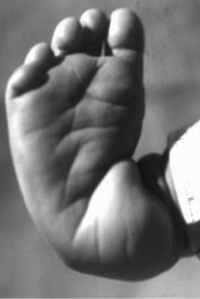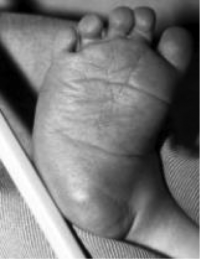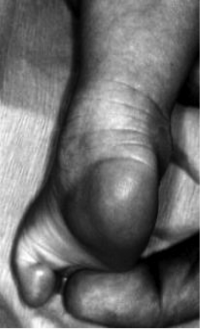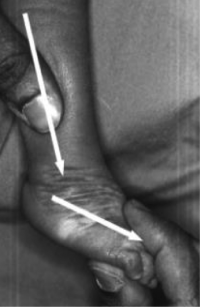Pirani Score Example
Original Editor - Your name will be added here if you created the original content for this page.
Top Contributors - Naomi O'Reilly and Kim Jackson
Introduction[edit | edit source]
Scoring the foot at each visit during treatment enables the health care worker treating the child to document how the foot is responding to manipulation and casting.
Pirani Score Assessment[edit | edit source]
Example 1[edit | edit source]
Medial Crease[edit | edit source]
What is the Medial Crease Score? [1]
Lateral Border[edit | edit source]
What is the Lateral Border Score? [1]
Posterior Crease[edit | edit source]
What is the Posterior Crease Score? [1]
Rigid Equinus Score[edit | edit source]
If this is the maximum dorsiflexion, what is the Rigid Equinus Score? [1]
Example 2[edit | edit source]
After assessment with the Pirani Score, you find: [1]
- Medial Crease (MC) = 0
- Curved Lateral Border (CLB) = 0.5
- Lateral Head of Talus (LHT) = 0
- Posterior Crease (PC) = 1
- Empty Heel = 0.5
- Rigid Equinus = 0.5
What is the Total Midfoot Score?
What is the Total Hindfoot Score?
What is the Total Pirani Score?
Is this patient ready to undergo Tenotomy?
Example 3[edit | edit source]
Based on the following Pirani Scores, which of these patients is ready for Tenotomy? [1]
Patient 1: CLB 0, LHT 0.5, MC 0, PC 0.5, RE 1.0, EH 1.0 Total Score = 3
Patient 2: CLB 0, LHT 0, MC 0, PC 1.0, RE 1.0, EH 1.0 Total Score = 3
Patient 3: CLB 0, LHT 0, MC 0.5, PC 1.0, RE 1.0, EH 0.5 Total Score = 3










